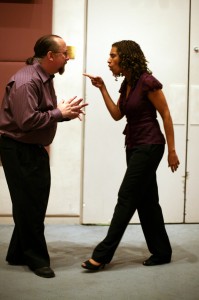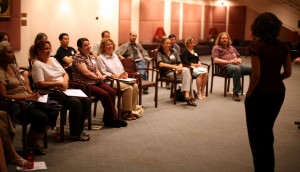We’ve all had that horrible moment. The presentation where we suddenly can’t get the words out. The big exam, and we can’t remember anything we’ve studied. The music performance where our fingers won’t work any more.
What’s behind this painful self-sabotage?
Jonah Lehrer discussed the latest research on his always-excellent blog,
The Frontal Cortex. Choking could be described as the analytical function of the mind interfering with an “automated” action — one that we’ve learned so well that our own verbal prompting impairs our ordinarily smooth operation. (Think of what happens to your golf swing when you’re telling yourself, “Wrists straight! Head down!)
Surprisingly, we can actually help prevent choking by concentrating not on the details of our action but on what the experimenters called a “holistic cue word,” such as “smooth” or “balanced.”
This finding reminds me of a practice my teacher
Cliff Missen showed me when I first learned African-style drumming. If you focus on your hands or try to count beats, you’ll mess up every time. But you can keep yourself in the rhythm if you make up a little phrase (nonsense is fine) that recites your part. For example, one drummer had a rhythm that was played exactly like “I’m ex-TREME-ly late.” All she had to do was mentally recite that sentence and play along.
This technique was fabulous for me, since I’m prone to verbal intrusions into everything and tend to argue and discuss with myself while I’m trying to do something else. Reciting my piece kept my overactive verbal mind happy and left my hands free to do some drumming! And usually I was able to drop the recitation at some point in the drumming session and just enjoy the groove.
As my Tibetan Buddhist teacher
Ven. Tsoknyi Rinpoche used to say, “You’ve got to throw your mind a lamb chop to keep it happy.” Another term for this process, I believe, is what
Jill Bolte Taylor calls “stepping to the right”: dropping the intrusive mental process of rehashing and hectoring that we call thinking, and allowing a more holistic sensibility to take over — which it’s generally dying to do!





